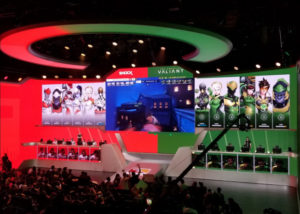The rise of esports as a spectator phenomenon
 In October 1972 at Stanford University, the first known video game competition took place. A handpicked list of the best Spacewar! players at the school were invited to watch and compete, and the lucky winner would take home a subscription to Rolling Stone magazine.
In October 1972 at Stanford University, the first known video game competition took place. A handpicked list of the best Spacewar! players at the school were invited to watch and compete, and the lucky winner would take home a subscription to Rolling Stone magazine.
Stanford was the location for the event because its Artificial Intelligence Lab was one of the few places with enough advanced hardware to run the game. According to event organizer Stewart Brand, very few people in the world even knew that they could play games on computers; the first Pong cabinet would not be installed until several weeks after the Spacewar! tournament.
For a game to become a sport, it needs three core components: competition, tournaments and spectators.
The world changed again in 1988 when Netrek, the first team-based internet game (and third internet game overall), was introduced.
Players no longer needed to track down a friend at the arcade to battle; their opponent could be on the other side of the world or in a house down the street.
Growth of esports
Three core elements are contributing to the esports industry’s rise as the next major spectator sport: streamed competitions with organized leagues, professional players that can be viewed anywhere, and live events in major offline sports venues. If you want to see how this plays out in real time, there’s no better place to go than Twitch, where people from all over the world can tune in and watch gamers, or “streamers,” play video games.
Today, Twitch has approximately 5 million active viewerswho spend 106 minutes each day watching live gaming, which ranks higher than prime time cable TV networks like CNN. Overall, the global esports audience is projected to double in the next three years from 300 million to more than 600 million viewers – and by the end of this year, 1.6 billion people will have some knowledge of esports.
Headline esports tournaments fill major stadiums and draw traveling audiences and media like any marquee offline sporting event. In 2014, Seoul’s Sangam Stadium – a venue used in the 2002 FIFA World Cup — hosted 45,000 in-person attendees to watch the League of Legends World Final. More than 27 million additional fans watched online. The 2017 League of Legends World Final in Beijing was viewed by 60 million people, up from 43 million the previous year.
See the full story here: https://venturebeat.com/2018/11/30/the-rise-of-esports-as-a-spectator-phenomenon/
Pages
- About Philip Lelyveld
- Mark and Addie Lelyveld Biographies
- Presentations and articles
- Tufts Alumni Bio